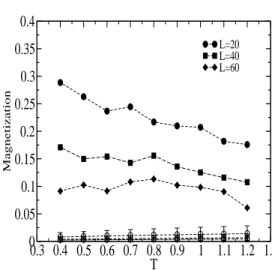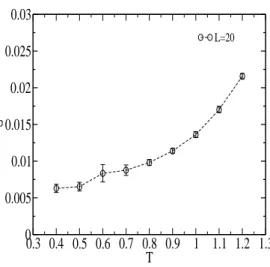672 Brazilian Journal of Physics, vol. 36, no. 3A, September, 2006
Monte Carlo Simulations of Ultrathin Magnetic Dots
M. Rapini, R. A. Dias, B. V. Costa,
Laborat´orio de Simulac¸˜ao - Departamento de F´ısica - ICEX - UFMG 30123-970 Belo Horizonte - MG, Brazil
and D. P. Landau
Center for Simulational Physics, University of Georgia, Athens, Georgia 30602
Received on 19 September, 2005
In this work we study the thermodynamic properties of ultrathin ferromagnetic dots using Monte Carlo simu-lations. We investigate the vortex density as a function of the temperature and the vortex structure in monolayer dots with perpendicular anisotropy and long-range dipole interaction. The interplay between these two terms in the hamiltonian leads to an interesting behavior of the thermodynamic quantities as well as the vortex density.
Keywords: Monte Carlo; Ultrathin films; Phase transition
I. INTRODUCTION
Magnetism at nanoscale, when the size of the structure is comparable to or smaller than both the ferromagnetic (FM) and antiferromagnetic (AF) domain size, offers a great po-tential for new physics. In the last decade there has been an increasing interest in ultrathin magnetic dots from research groups as well as technological industries. Such an interest is due to numerous unique phenomena related to the low-dimension of these systems.
The modern technology demands techniques capable of producing nanometer-sized structures over large areas. A good perspective is the use of nanodots of nickel that could store terabyte of data in a computer chip just a few centime-ters wide. In particular, ferromagnetic nanodots have been widely studied by use of experimental techniques such as MFM (magnetic force microscopy). In addition, some theo-retical models were proposed to explain the physical phenom-ena observed in the experiments, among them the transition from perpendicular to in-plane ordering and the magnetore-sistence effect.
Regarding the perpendicular to in-plane ordering transition,
experiments were done using epitaxial films to investigate its transition temperature and thickness dependence [2] [3]. In addition, many theoretical approaches were developed, for ex-ample, treating a two-dimensional layer by renormalization group [4]. Some lattice models were proposed to take into ac-count long-range dipolar interactions and surface anisotropy [5].
Based on such models, Monte Carlo simulations have been widely used to study the phase diagram of very thin films [6], the nature of this transition [7] as well as its dependence on the magnetic history of the system [8]. On the other hand, mag-netic domains [9] and magmag-netic structures [10] have also been investigated by using computational methods. A topological excitation, the spin vortex, has been found in experiments and also detected in simulations. Vortex structures are believed to drive a Bereziinski-Kosterlitz-Thouless (BKT) phase tran-sition in the two dimensional planar-rotator (PR) model [11]. Although vortices are present in thin films with long range in-teractions, it is not clear if they play any role in the transition. The model we study is described by the Heisenberg spin hamiltonian with exchange and long-range dipolar interac-tions as well as single-ion anisotropy
H=−J
∑
<i j>Si·Sj+D
∑
i6=kSi·Sk r3ik −3
(Si·rik)(Sk·rik) r5
ik
−A
∑
i(Szi)2 , (1)
where we use classical spins |S| =1. Here the first sum is performed over nearest neighbors with exchange coupling strenght,J>0 , while the second sum runs over all spin pairs in the lattice. The constant of dipole coupling is D, rik is a vector connecting theiandksites andAis the single-site anisotropy constant along the z-axis[5].
The main task in this work is to study the importance of vortices in the physics of the model. Although preliminary, our results indicate an anomalous behavior of the vortex density at the transition temperature forδ=D
A ≪1. In the following we present a brief background on the simulation,
our results and the conclusions.
Method
M. Rapini et al. 673
conditions in the non dipolar terms while for the dipolar term we have used open conditions.
We have studied the model for three different values of the parametersAandD,δ=D
A=0.1,1.0 and 9.0 for fixedJ=1. Energy is measured in units ofJS2and temperature in units ofJS2/kB, wherek
Bis the Boltzman constant. For every tem-perature the first 105MC steps per spin were used to lead the system to equilibrium and the next 105 configurations were used to calculate thermal averages of thermodynamical quan-tities of interest.
II. RESULTS
In the case whereδ=0.1, we measured the out-of-plane (z) and in-plane (xy) magnetizations (Shown in Fig. 1).
0.1 0.2 0.3 0.4 0.5 0.6 0.7 0.8 0.9 1 1.1 1.2 1.3 T
0 0.1 0.2 0.3 0.4 0.5 0.6 0.7 0.8 0.9 1
Magnetization
L=20 L=40 L=60
FIG. 1: Out-of-plane and in-plane magnetization (open and full sym-bols) forδ=0.1
The system comes from an ordered state at low tempera-ture to a disordered state at high temperatempera-ture. That behav-ior indicates an order-disorder phase transition atTc≈0.55. The in-plane magnetization, Mxy, grows presenting a maxi-mum close to the order-disorder critical temperatureTc. How-ever, the height of the peak diminishes asLgrows, in a clear indicative that it is a finite size artifice.
The magnetic susceptibility is shown in Fig. 2. The posi-tion of the maxima give us an estimate forTc(≈0.55).
We also measured the vortex density in thexy plane as a function of the temperature. Starting from the highest temper-ature,T =1.2, the number of vortex decreases and reaches a minimum. Then it starts to increase as the system is cooled down. This behavior is shown in Fig.3 and the graphics indi-cate that the ground state of the system has a significant num-ber of vortices and anti-vortices in thexyplane. Apparently, the minimum of the vortex curve is connected with the transi-tion to in-plane magnetizatransi-tion, however, we were not able to establish that connection.
Forδ=1.0 the behavior of the in-plane and out-of-plane magnetizations (See Fig. 4), suggest that the ground state is
0.1 0.2 0.3 0.4 0.5 0.6 0.7 0.8 0.9 1 1.1 1.2 1.3 T
0 10 20 30 40 50
χ
L=20 L=40 L=60
FIG. 2: Out-of-plane (open symbols) and in-plane (full symbols) sus-ceptibilities forδ=0.1.
0.1 0.2 0.3 0.4 0.5 0.6 0.7 0.8 0.9 1 1.1 1.2 1.3 T
0.06 0.08 0.1 0.12 0.14 0.16 0.18 0.2
ρ
L=20 L=40 L=60
FIG. 3: Vortex density in thexyplane forδ=0.1.
0.3 0.4 0.5 0.6 0.7 0.8 0.9 1 1.1 1.2 1.3 T
0 0.1 0.2 0.3 0.4 0.5 0.6 0.7 0.8 0.9 1
Magnetization
L=20 L=40 L=60
674 Brazilian Journal of Physics, vol. 36, no. 3A, September, 2006
disordered in contrast to earlier works of Santamaria [6] and Vedmedenko [10] that argue that the ground state is for spins ordered in thexyplane. A plot of the susceptibility is shown in Fig. 5 as a function of temperature. Although some authors [6, 10] concluded that this transition is of second order, the curves show well defined maxima that do not seem to indicate any critical behavior.
0.3 0.4 0.5 0.6 0.7 0.8 0.9 1 1.1 1.2 1.3 T
0 5 10 15 20 25 30 35 40
χ
L=20 L=40 L=60
FIG. 5: In-plane susceptibility forδ=1.0. The lines are only a guide to the eye.
The vortex density curve in thexyplane is shown in Fig. 6. We see that the number of vortices increases monotonically from zero as a function of temperature. As temperature grows we observed that the spins in the lattice start to disorder, so that pairs vortices-anti-vortices can unbind inducing a BKT transition. However our results are not refined enough to de-cide that. In Fig. 7 we show two typical configurations for T =0.8 and 1.2 where the vortices are indicated by circles and the anti-vortices by squares.
0.1 0.2 0.3 0.4 0.5 0.6 0.7 0.8 0.9 1 1.1 1.2 1.3 T
0 0.01 0.02 0.03 0.04 0.05
ρ
L=20
FIG. 6: Vortex density in thexy-plane forδ=1.0. For systems with largerδ, for example,δ=9.0, the spins are preferentially in thexyplane but it does not present any
FIG. 7: Configurations of the system withδ=1.0 forT =0.8 e T=1.2. The vortices are indicated by spheres and the anti-vortices by cubes.
0.3 0.4 0.5 0.6 0.7 0.8 0.9 1 1.1 1.2 1.3 T
0 0.05 0.1 0.15 0.2 0.25 0.3 0.35 0.4
Magnetization
L=20 L=40 L=60
FIG. 8: Out-of-plane and in-plane magnetization (open and full sym-bols) forδ=9.0.
M. Rapini et al. 675
0.3 0.4 0.5 0.6 0.7 0.8 0.9 1 1.1 1.2 1.3 T
0 0.005 0.01 0.015 0.02 0.025 0.03
ρ
L=20
FIG. 9: Vortex density in thexy-plane forδ=9.0.
III. CONCLUSION
In summary, we investigated the Heisenberg spin model with exchangeJand dipolar interactionsDand an anisotropic
termAfor different parametersδ=D
A. For smallδ, (0.1), we observed that the vortex density has a minimum and is non-zero for low temperatures. Apparently, this minimum is nected with the order-disorder phase transition but this con-nection has to be studied more carefully. For larger values ofδ (1.0 and 9.0) the vortex density and the configurations of vortices in the system led us to suspect of a phase transi-tion of the BKT type involving the unbinding of vortices-anti-vortices pairs. However our results are not refined enough to decide that.
Acknowledgments
BVC would like to thank the Center for Simulational Physics at the University of Georgia for its hospitality. This work was funded by CNPq and FAPEMIG, Brazilian agen-cies, and CIAM-CNPq Process Grant No. 49.0101/03-8, NASA Grant No. NNC04GB24 and NSF Grants Nos. DMR-0341874 and DMR-0307082.
[1] Electronic mail: mrapini@fisica.ufmg.br
[2] R. Allenspach, A. Bischof, Phys. Rev. Lett.69, 3385 (1992). [3] D. P. Pappaset al., J. Appl. Phys.69, 5209 (1991).
[4] D. Pescia, V. L. Pokrovsky, Phys. Rev. Lett.65, 2599 (1990). [5] A. Moschel, K. D. Uasdel, Phys. Rev. B49, 12868 (1994). [6] C. Santamaria, H. T. Diep, J. Magn. Magn. Mat.212, 23 (2000). [7] A. Hucht, A. Moschel, and K. D. Usadel, J. Magn. Magn. Mat.
148, 32 (1995).
[8] O. Iglesias, A. Valencia, and A. Labarta, J. Magn. Magn. Mat. 196, 819 (1999).
[9] F. Matsubara, S. Endoh, J. Magn. Magn. Mat.272, 679 (2004). [10] E. Y. Vedmedenko, A. Ghazali, and J. C. S. L´evy, Surface
Sci-ence402-404, 391 (1998).
[11] J. B. Kogut, Rev. Mod. Phys51, 659 (1979).
[12] J. M. Thijssen,Computational Physics, Cambridge University Press (1999).


